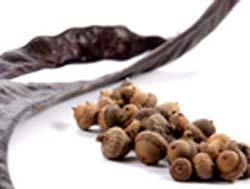
Many small seed-eating rodents bury their food in an erratic manner called scatter-hoarding because they are unable to defend one large hoard. This process has a complicated influence on seed dispersal, as shown in the work by ZHANG Zhibin at the CAS Institute of Zoology and his co-workers.
Zhang and co-workers collected acorns from Liaodong oak trees in the Dongling mountains, northern China. The acorns were tagged and scattered around a feeding station. The researchers monitored the fate of acorns eaten or buried by local rodents -- mainly Chinese white-bellied rats and Korean field mice.
They found that small acorns were often eaten immediately by rodents, whereas larger acorns were more likely to be taken away and buried in a cache. However, the larger acorns were less likely to survive the caching process than small acorns -- possibly because their stronger smell encourages other rodents to dig them up. Out of 2,400 acorns in the experiment, only 6 survived until spring -- 3 large and 2 small acorns were found in shrubland, and 1 small acorn was found in a forest.
The findings show that size and habitat have no significant effect on the survival of large or small acorns, but large acorns tend to be carried further away from the source than small acorns.( Tim Reid, Nature China)





